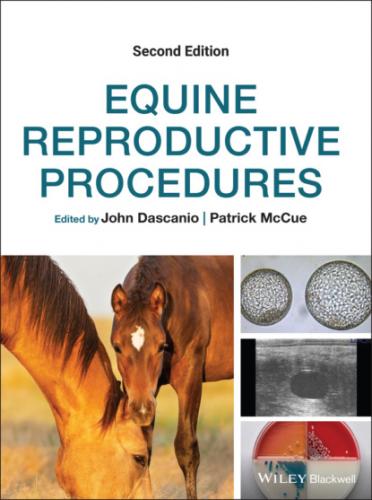Estrous Detection
See also Chapter 2. The mare should be exposed to a stallion with good libido to evaluate estrous cycle stage. Adequate time should be taken to allow shy or nervous mares to express behavioral estrus. When teasing a mare with a foal, the foal must be restrained, and the mare may need to be restrained with a twitch before signs of estrus are exhibited.
Palpation Per Rectum
See also Chapter 7. The entire reproductive tract, including the cervix, uterus, and ovaries, should be thoroughly and systematically examined by palpation per rectum. The tone of the uterus and cervix, size and consistency of ovarian follicles, and the presence of a recent ovulation or a corpus hemorrhagicum should be recorded. The presence of abnormal ovarian, parovarian (i.e., fimbrial cysts), or uterine structures should be recorded.
Ultrasonography Per Rectum
See also Chapter 8. Manual palpation should be followed by a systematic ultrasound evaluation of the entire reproductive tract. Ultrasound is used in broodmares to visualize structures in the reproductive tract that cannot be palpated or differentiated on palpation per rectum, and in the early diagnosis of pregnancy, diagnosis of twins, and evaluation of potential ovarian or uterine pathology.
Vaginal Speculum Examination
See also Chapter 10. A vaginal speculum examination is performed to evaluate the anatomy of the vagina and the external os of the cervix. Speculum examination is useful in determination of the stage of the estrous cycle (via cervical morphology and vaginal mucous membrane changes), and detection of urine pooling and the presence of cervical/vaginal inflammation or discharge.
Digital Examination of the Cervix
See also Chapter 11. After the speculum examination is completed, the cervix should be examined manually for patency and the presence of abnormalities, such as adhesions, lacerations, or other cervical defects.
Uterine Culture
See also Chapter 12. Culture of the uterine lumen is usually performed in conjunction with cytology for the diagnosis of endometritis. Endometritis can be suspected in mares that exhibit an abnormally short estrous cycle, vaginal or cervical discharge, inflamed cervix on speculum examination, and free fluid in the uterus during diestrus detected on ultrasound.
Endometrial Cytology
See also Chapter 17. Cytologic evaluation of the uterus involves the collection and interpretation of cells lining the uterus (endometrium) and within the uterine lumen. Cytology is used in conjunction with culture and biopsy in the diagnosis of endometritis. Advantages of endometrial cytology for the diagnosis of endometritis include the ease of sample collection, low cost, and rapid availability of results.
Endometrial Biopsy
See also Chapter 19. Endometrial biopsy involves collection of a small sample of the uterine lining (endometrium) for histologic evaluation. It is primarily used as an aid in the diagnosis of uterine disease and as a prognostic indicator of the ability of a mare to carry a foal to term. An endometrial biopsy can also be used as the sample source for culture and cytologic evaluation.
Other Tests
The standard examination procedures in the mare BSE may not identify the cause of subfertility. Consequently, other examinations may be indicated (Table 1.1).
Additional Comments
Interpretation of the results of a mare BSE should take into account the mare’s age, reproductive history, breed, stallion, breeding management, and other factors. Ultimately the goals are to determine the potential for fertility and detect abnormalities that may be associated with reduced fertility. Management and therapeutic options may be outlined to help optimize a successful outcome. It is important to emphasize that a mare BSE is only an evaluation of potential fertility and that the true assessment of fertility is the ability of the mare to conceive and carry a foal to term.
Table 1.1 Diagnostic tests that may be performed in addition to the standard tests in a mare breeding soundness evaluation.
| Test | Indication |
|---|---|
| Chromosome analysis (karyotype) | Evaluate numeric or structural changes in chromosomes |
| Hormone analysis | Evaluate pituitary and/or ovarian endocrine function. Most commonly used to evaluate corpus luteum function and in the detection of an ovarian granulosa cell tumor |
| Hysteroscopy | Direct visualization of the interior of the uterus to detect intrauterine adhesions and other localized lesions, as well as inflammation and fibrosis |
| Laparoscopy | Direct visualization of the serosal surface of the ovary, oviduct, uterus, and abdominal cavity. Also used in ovarian biopsy, evaluation of oviductal patency, and the application of prostaglandin E2 (PGE2) to the oviductal surface |
| Low volume lavage | Collection of uterine samples for culture, cytology, and other evaluations (e.g., polymerase chain reaction). The effluent fluid may also be evaluated for clarity and pH |
| Oviductal flush | Performed by laparotomy, laparoscopy, or via videoendoscopy; used both diagnostically and therapeutically in suspected cases of oviductal blockage |
| Oviductal patency test | Deposition of fluorescent microbeads or starch granules onto the surface of the ovary or possibly within the infundibulum of the oviduct and subsequent examination of the uterine lumen for passage of the test material is used diagnostically to evaluate oviductal patency |
| Oviductal PGE2 application | Direct application of PGE2 can be used diagnostically and therapeutically in suspected cases of oviductal blockage |
| Ovarian biopsy | Laparoscopic collection of ovarian tissue for histologic evaluation may be used in the diagnosis of ovarian pathology |
| Test breed | Breeding to a highly fertile stallion can be used diagnostically to help determine if the mare is a cause of subfertility or infertility |
Further Reading
